
views
X
Research source
If you're writing a research paper on a political or legal issue, you may want to use an executive order as a source. The exact format of your citation depends on whether you use the Modern Language Association (MLA), American Psychological Association (APA), or Chicago citation style.
MLA

List the government and the president as authors. Start with "United States," followed by a comma. Then type "Executive Office of the President" as the author. Include the president's name in square brackets after the name of the executive office to clarify which president signed the order. Place a period after the closing brackets. Example: United States, Executive Office of the President [Barack Obama].
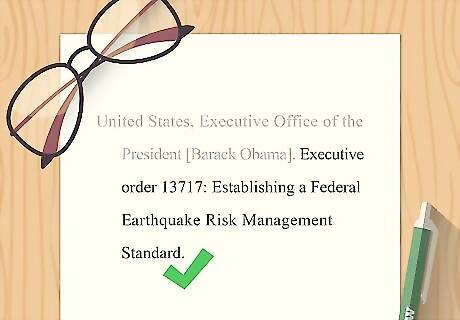
Provide the number and title of the executive order. Type the words "Executive order" followed by the number assigned to the order. Place a colon after the number, then type the full title of the executive order. Use title case, capitalizing all nouns, pronouns, verbs, and adverbs. Place a period at the end of the title. Example: United States, Executive Office of the President [Barack Obama]. Executive order 13717: Establishing a Federal Earthquake Risk Management Standard.

Include the date the order went into effect. After the title, type the date the president signed the order in day-month-year format. Use 3-letter abbreviations for all months with names longer than 4 letters. Place a period after the date. Example: United States, Executive Office of the President [Barack Obama]. Executive order 13717: Establishing a Federal Earthquake Risk Management Standard. 2 Feb. 2016.
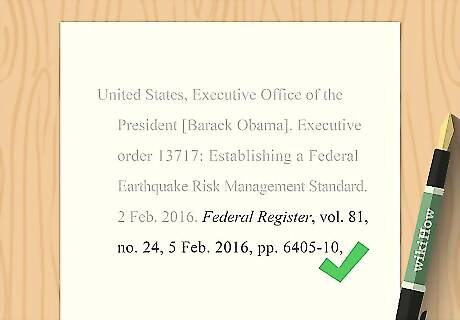
Add publication information for the Federal Register. Italicize the name of the publication, followed by a comma. List the volume and issue number for the Federal Register, separated by a comma. Add another comma and include the date of publication in day-month-year format. Place a comma after the date, then type the abbreviation "pp." followed by the page range where the executive order appears. Place a period after the page numbers, unless you are adding a direct URL. Example: United States, Executive Office of the President [Barack Obama]. Executive order 13717: Establishing a Federal Earthquake Risk Management Standard. 2 Feb. 2016. Federal Register, vol. 81, no. 24, 5 Feb. 2016, pp. 6405-10,
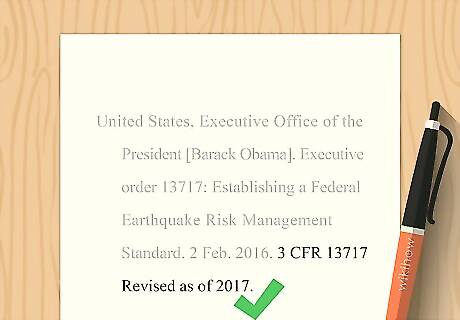
Follow a different format for CFR publication information. If the executive order has already been published in the CFR, start with the volume in which the order was published. For executive orders, this will be "3." Then type the letters "CFR," followed by the number of the executive order. Type the words "Revised as of" followed by the year the CFR was last updated. Place a period after the year, unless you are adding a direct URL. Example: United States, Executive Office of the President [Barack Obama]. Executive order 13717: Establishing a Federal Earthquake Risk Management Standard. 2 Feb. 2016. 3 CFR 13717 Revised as of 2017.
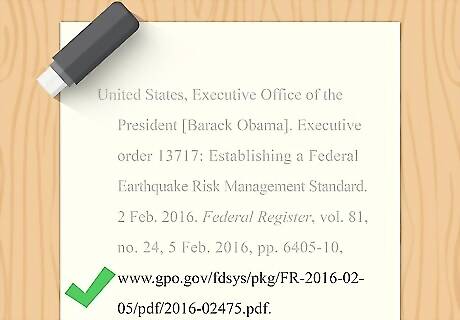
Close with the direct URL if you accessed the order online. In MLA style, you cite to the specific copy of the executive order that you looked at. If you read the executive order online, add a direct URL to the executive order in addition to the publication information. Do not include the "http://" at the beginning of the URL. Place a period at the end. Example: United States, Executive Office of the President [Barack Obama]. Executive order 13717: Establishing a Federal Earthquake Risk Management Standard. 2 Feb. 2016. Federal Register, vol. 81, no. 24, 5 Feb. 2016, pp. 6405-10, www.gpo.gov/fdsys/pkg/FR-2016-02-05/pdf/2016-02475.pdf. MLA Works Cited Format Federal Register:United States, Executive Office of the President [First Name Last Name]. Executive order xxxxx: Executive Order Title. Day Month Year. Federal Register, vol. xx, no. xx, Day Month Year, pp. xx-xx, URL. CFR:United States, Executive Office of the President [First Name Last Name]. Executive order xxxxx: Executive Order Title. Day Month Year. 3 CFR xxxxx Revised as of Year.
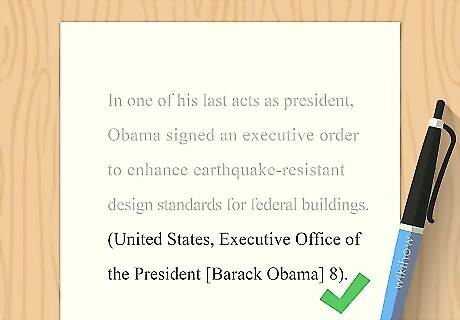
List the government and president in your in-text citation. After you paraphrase or quote the executive order in the body of your paper, include a parenthetical citation at the end of the sentence. Include the entire "author" portion of your Works Cited entry, along with the relevant page number. Place a period outside the closing parentheses. Example: "In one of his last acts as president, Obama signed an executive order to enhance earthquake-resistant design standards for federal buildings. (United States, Executive Office of the President [Barack Obama] 8)." MLA In-Text Citation Format (United States, Executive Office of the President [First Name Last Name] Page#).
APA

Begin your citation with the executive order number. APA style does not list an author for executive orders. Type "Exec. Order No." followed by the number assigned to the executive order. Place a comma after the number. Example: Exec. Order No. 13648,
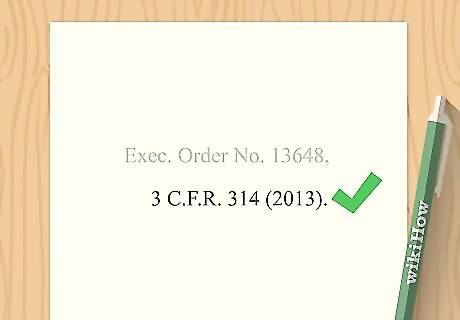
List the volume number, name of the code, page number, and year. Executive orders always appear in volume 3 of the CFR. After the number, type "C.F.R." Then type the starting page for the executive order. Add the year the order was signed in parentheses. Place a period after the closing parentheses. Example: Exec. Order No. 13648, 3 C.F.R. 314 (2013).

Cite to the Federal Register if the executive order isn't in the CFR yet. The format for citing to the Federal Register is similar to the format for the C.F.R. type the volume, then "Fed. Reg." Follow that with the starting page for the executive order. Include the date the Federal Register was published in parentheses. Use month-day-year format for the date. Place a period outside the closing parentheses. Example: Exec. Order No. 13648, 78 Fed. Reg. 129 (July 5, 2013). APA Reference List Entry Format Federal Register:Exec. Order No. xxxxx, Vol.# Fed. Reg. Page# (Month Day, Year). CFR:Exec. Order No. xxxxx, 3 CFR Page# (Year).

Use the executive order number and year for in-text citations. Place a parenthetical citation at the end of any sentence in which you have paraphrased or quoted the executive order. Use the executive order number, placing commas between the digits where applicable. Place a comma at the end of the number, then add the year the executive order was signed. Place a period after the closing parentheses. Example: "President Obama issued an executive order to protect endangered species from poaching and illegal trade (Exec. Order No. 13,648, 2013)." If you happen to include the executive order number in your text, simply place a parenthetical immediately after the number with the year the executive order was signed. For example: "Executive Order 13,648 (2013) introduced sanctions and import restrictions for poachers of protected wildlife species." APA In-Text Citation Format (Exec. Order No. xx,xxx, Year).
Chicago
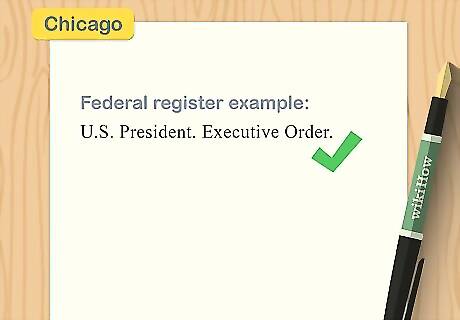
List the president as the author for orders in the Federal Register. The president personally is not the author of an executive order, the office of the president is. Therefore, type "U.S. President" as the "author" of the order, followed by a period. Add the words "Executive Order," then type another period. Example: U.S. President. Executive Order.
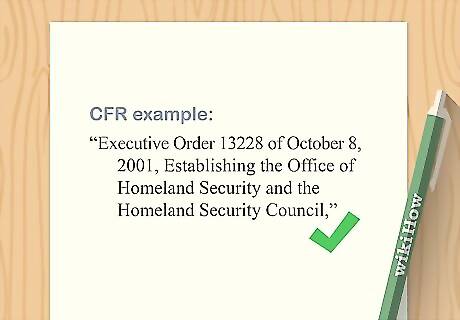
Start with the executive order number and title for orders in the CFR. Open quotation marks, then type the words "Executive Order" followed by the executive order number. Type the word "of" and then provide the date the order was signed in month-day-year format. Place a comma after the date, then type the title of the order. Place a comma after the title, inside the closing quotation marks. Example: "Executive Order 13228 of October 8, 2001, Establishing the Office of Homeland Security and the Homeland Security Council,"
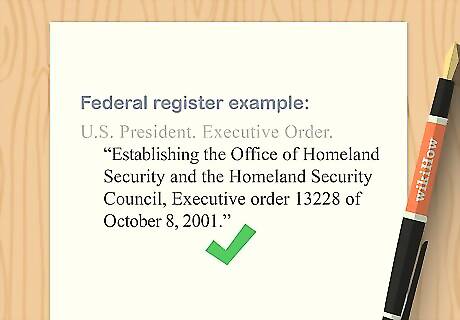
Use a different format for titles of orders in the Federal Register. Open quotation marks, then type the title of the executive order. Place a comma after the title, then type the words "Executive order." Add the executive order number, then type the word "of." Type the date the order was signed in month-day-year format. Place a period after the date, inside the closing quotation marks. Example: U.S. President. Executive Order. "Establishing the Office of Homeland Security and the Homeland Security Council, Executive order 13228 of October 8, 2001."
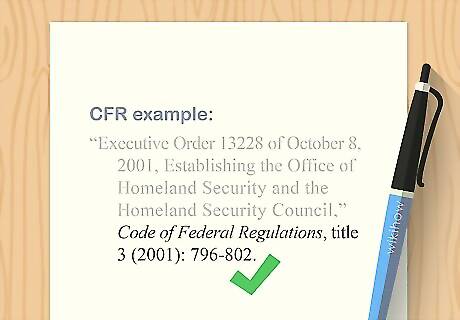
Provide publication information and page numbers. For Federal Register orders, type "Federal Register" in italics followed by the volume number. Place a comma, then type the abbreviation "no." followed by the issue number. Place the publication date in parentheses, followed by a colon. Type the starting page number of the order followed by a period. For CFR orders, type "Code of Federal Regulations" in italics, followed by a comma. Add "title 3," followed by the year in parentheses. Place a colon after the closing parentheses, then type the page range where the executive order appears. Place a period after the final page number. Federal register example: U.S. President. Executive Order. "Establishing the Office of Homeland Security and the Homeland Security Council, Executive order 13228 of October 8, 2001." Federal Register 66, no. 196 (October 10, 2001): 51812. CFR example: "Executive Order 13228 of October 8, 2001, Establishing the Office of Homeland Security and the Homeland Security Council," Code of Federal Regulations, title 3 (2001): 796-802.
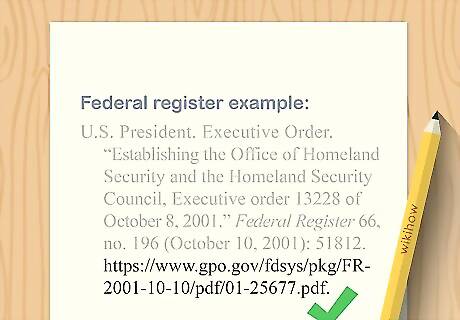
Include a direct URL for the executive order. At the end of your citation, include the full URL for the government website where the executive order can be found. Typically this will be the website for the Government Printing Office (GPO), although executive orders are also published on the White House website. Place a period at the end of the URL. Federal register example: U.S. President. Executive Order. "Establishing the Office of Homeland Security and the Homeland Security Council, Executive order 13228 of October 8, 2001." Federal Register 66, no. 196 (October 10, 2001): 51812. https://www.gpo.gov/fdsys/pkg/FR-2001-10-10/pdf/01-25677.pdf. CFR example: "Executive Order 13228 of October 8, 2001, Establishing the Office of Homeland Security and the Homeland Security Council," Code of Federal Regulations, title 3 (2001): 796-802. https://www.gpo.gov/fdsys/pkg/CFR-2002-title3-vol1/pdf/CFR-2002-title3-vol1-eo13228.pdf. Chicago Bibliography Entry Format Federal Register:U.S. President. Executive Order. "Title of Executive Order, Executive order xxxxx of Month Day, Year." Federal Register Vol.#, no. xxx (Month Day, Year): Page#. URL. CFR:"Executive Order xxxxx of Month, Day, Year, Title of Executive Order," Code of Federal Regulations, title 3 (Year): Page Range. URL.
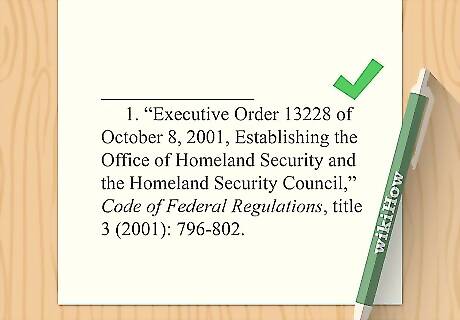
Use commas to separate elements in footnotes in-text. When you paraphrase or quote the executive order, place a superscript footnote number at the end of the sentence. Your footnote contains the same information as the bibliographic citation. However, elements of the citation are separated with commas rather than periods. Federal register example: U.S. President, Executive Order, "Establishing the Office of Homeland Security and the Homeland Security Council, Executive order 13228 of October 8, 2001," Federal Register 66, no. 196 (October 10, 2001): 51812. CFR example: "Executive Order 13228 of October 8, 2001, Establishing the Office of Homeland Security and the Homeland Security Council," Code of Federal Regulations, title 3 (2001): 796-802. Chicago Footnote Format Federal Register:U.S. President, Executive Order, "Title of Executive Order, Executive order xxxxx of Month Day, Year," Federal Register Vol.#, no. xxx (Month Day, Year): Page#, URL. CFR:"Executive Order xxxxx of Month, Day, Year, Title of Executive Order," Code of Federal Regulations, title 3 (Year): Page Range, URL.













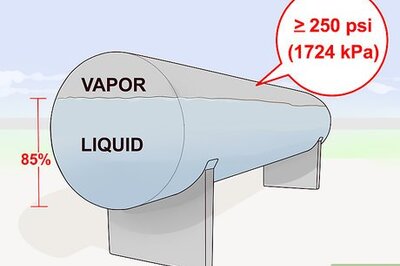





Comments
0 comment